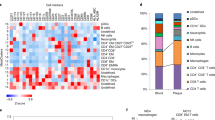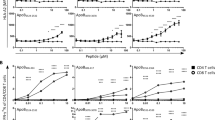Abstract
Considerable evidence indicates that type 1 T helper (Th1)- and Th17-mediated immune responses promote the formation of atherosclerotic plaques while that CD4+CD25+Foxp3+ regulatory T cells (Tregs) have a protective effect. However, the functions of diverse CD4+ lymphocyte subsets in plaque rupture remain poorly understood because of a shortage of satisfactory plaque rupture models. Here, we established a murine model of atherosclerotic plaque rupture using a high-fat diet and collar placement on the carotid artery, and triggered plaque rupture by short-term stimulation with a combination of lipopolysaccharide, phenylephrine injection and cold in apolipoprotein E-knockout (ApoE−/−) mice. We investigated the associations between Th1 cells, Th17 cells and Tregs and plaque rupture by PCR, flow cytometry, ELISA and immunohistochemistry. In total, 75% (18/24) of vulnerable plaques, but no stable plaques, showed rupture characteristics. The proportion of Th17 cells was increased among splenocytes after treatment, but the changes in the levels of Th1 cells and Tregs were not related to rupture. Furthermore, the treatment resulted in high levels of interleukin-17 (IL-17) in the serum and in the region of plaque rupture. In vitro, IL-17 increased the level of apoptosis, a major factor associated with plaque rupture, in cultured murine vascular smooth muscle cells. Th17 cells and IL-17 may be involved in the disruption of vulnerable plaques triggered by short-term stimulation with lipopolysaccharide, phenylephrine injection and cold in ApoE−/−mice.
This is a preview of subscription content, access via your institution
Access options
Subscribe to this journal
Receive 12 digital issues and online access to articles
$119.00 per year
only $9.92 per issue
Buy this article
- Purchase on Springer Link
- Instant access to full article PDF
Prices may be subject to local taxes which are calculated during checkout







Similar content being viewed by others
References
Kumar A, Cannon CP . Acute coronary syndromes: diagnosis and management, part I. Mayo Clin Proc 2009; 84: 917–938.
Kumar A, Cannon CP . Acute coronary syndromes: diagnosis and management, part II. Mayo Clin Proc 2009; 84: 1021–1036.
Rosenfeld ME, Polinsky P, Virmani R, Kauser K, Rubanyi G, Schwartz SM . Advanced atheroscleroticlesions in the innominate artery of the ApoE knockout mouse. Arterioscler Thromb Vasc Biol 2000; 20: 2587–2592.
Zaman AG, Helft G, Worthley SG, Badimon JJ . The role of plaque rupture and thrombosis in coronary artery disease. Atherosclerosis 2000; 149: 251–266.
Rekhter MD . How to evaluate plaque vulnerability in animal models of atherosclerosis? Cardiovasc Res 2002; 54: 36–41.
Libby P . Inflammation in atherosclerosis. Nature 2002; 420: 868–874.
Hansson GK . Inflammation, atherosclerosis, and coronary artery disease. N Engl J Med 2005; 352: 1685–1695.
Hansson GK, Holm J, Jonasson L . Detection of activated T lymphocytes in the human atherosclerotic plaque. Am J Pathol 1989; 135: 169–175.
Hosono M, de Boer OJ, van der Wal AC, van der Loos CM, Teeling P, Piek JJ et al. Increased expression of T cell activation markers (CD25, CD26, CD40L and CD69) in atherectomy specimens of patients with unstable angina and acute myocardial infarction. Atherosclerosis 2003; 168: 73–80.
Wigren M, Nisson J, Kolbus D . Lymphocytes in atherosclerosis. Clin Chim Acta 2012; 413: 1562–1568.
Vinson A, Curran JE, Johnson MP, Dyer TD, Moses EK, Blangero J et al. Genetical genomics of Th1 and Th2 immune response in a baboon model of atherosclerosis risk factors. Atherosclerosis 2011; 217: 387–394.
Furuzawa-Carballeda J, Vargas-Rojas MI, Cabral AR . Autoimmune inflammation from the Th17 perspective. Autoimmun Rev 2007; 6: 169–175.
Xie JJ, Wang J, Tang TT, Chen J, Gao XL, Yuan J, et al. The Th17/Treg functional imbalance during atherogenesis in ApoE−/− mice. Cytokine 2010; 49: 185–193.
Mangan PR, Harrington LE, O'Quinn DB, Helms WS, Bullard DC, Elson CO et al. Transforming growth factor-beta induces development of the T (H) 17 lineage. Nature 2006; 441: 231–234.
Park H, Li Z, Yang XO, Chang SH, Nurieva R, Wang YH et al. A distinct lineage of CD4 T cells regulates tissue inflammation by producing interleukin 17. Nat Immunol 2005; 6: 1133–1141.
Veldhoen M, Hocking RJ, Atkins CJ, Locksley RM, Stockinger B . TGFbeta in the context of an inflammatory cytokine milieu supports de novo differentiation of IL-17-producing T cells. Immunity 2006; 24: 179–189.
Gao Q, Jiang Y, Ma T, Zhu F, Gao F, Zhang P et al. A critical function of Th17 proinflammatory cells in the development of atherosclerotic plaque in mice. J Immunol 2010; 185: 5820–5827.
Afzali GL, Lechler RI, Lord GM . The role of T helper 17 (Th17) and regulatory T cells (Treg) in human organ transplantation and autoimmune disease. Clin Exp Immunol 2007; 148: 32–46.
Yao R, Ma Y, Du Y, Liao M, Li H, Liang W et al. The altered expression of inflammation-related microRNAs with microRNA-155 expression correlates with Th17 differentiation in patients with acute coronary syndrome. Cell Mol Immunol 2011; 8: 486–495.
Li Q, Wang Y, Chen K, Zhou Q, Wei W, Wang Y et al. The role of oxidized low-density lipoprotein in breaking peripheral Th17/Treg balance in patients with acute coronary syndrome. Biochem Biophys Res Commun 2010; 394: 836–842.
Alexander MR, Moehle CW, Johnson JL, Yang Z, Lee JK, Jackson CL et al. Genetic inactivation of IL-1 signaling enhances atherosclerotic plaque instability and reduces outward vessel remodeling in advanced atherosclerosis in mice. J Clin Invest 2012; 122: 70–79.
Cheng X, Yu X, Ding YJ, Fu QQ, Xie JJ, Tang TT et al. The Th17/Treg imbalance in patients with acute coronary syndrome. Clin Immunol 2008; 127: 89–97.
Calara F, Silvestre M, Casanada F, Yuan N, Napoli C, Palinski W . Spontaneous plaque rupture and secondary thrombosis in apolipoprotein E-deficient and LDL receptor-deficient mice. J Pathol 2001; 195: 257–263.
Hu W, Polinsky P, Sadoun E, Rosenfeld ME, Schwartz SM . Atherosclerotic lesions in the common coronary arteries of ApoE knockout mice. Cardiovasc Pathol 2005; 14: 120–125.
Johnson JL, Jackson CL . Atherosclerotic plaque rupture in the apolipoprotein E knockout mouse. Atherosclerosis 2001; 154: 399–406.
Rosenfeld ME, Polinsky P, Virmani R, Kauser K, Rubanyi G, Schwartz SM . Advanced atherosclerotic lesions in the innominate arteryof the ApoE knockout mouse. Arterioscler Thromb Vasc Biol 2000; 20: 2587–2592.
Williams H, Johnson JL, Carson KG, Jackson CL . Characteristics of intact and ruptured atherosclerotic plaques in brachiocephalic arteries of apolipoprotein E knockout mice. Arterioscler Thromb Vasc Biol 2002; 22: 788–792.
Johnson J, Carson K, Williams H, Karanam S, Newby A, Angelini G et al. Plaque rupture after short periods of fat feeding in the apolipoprotein E-knockout mouse: model characterization and effects of pravastatin treatment. Circulation 2005; 111: 1422–1430.
von der Thüsen JH, van Berkel TJ, Biessen EA . Induction of rapid atherogenesis by perivascular carotid collar placement in apolipoprotein E-deficient and low-density lipoprotein receptor-deficient mice. Circulation 2001; 103: 1164–1170.
von der Thusen JH, van Vlijmen BJ, Hoeben RC, Kockx MM, Havekes LM, van Berkel TJ et al. Induction of atherosclerotic plaque rupture in apolipoprotein E−/− mice after adenovirus-mediated transfer of p53. Circulation 2002; 105: 2064–2070.
Ni M, Wang Y, Zhang M, Zhang PF, Ding SF, Liu CX et al. Atherosclerotic plaque disruption induced by stress and lipopolysaccharide in apolipoprotein E knockout mice. Am J Physiol Heart Circ Physiol 2009; 296: H1598–H1606.
Ni M, Chen WQ, Zhang Y . Animal models and potential mechanisms of plaque destabilization and disruption. Heart 2009; 95: 1393–1398.
Shah PK . Mechanisms of plaque vulnerability and rupture. J Am Coll Cardiol 2003; 41: 15S–22S.
Anogeianaki A, Angelucci D, Cianchetti E, D'Alessandro M, Maccauro G, Saqqini A et al. Atherosclerosis: a classic inflammatory disease. Int J Immunopathol Pharmacol 2011; 24: 817–825.
Stoll G, Bendszus M . Inflammation and atherosclerosis: novel insights into plaque formation and destabilization. Stroke 2006; 37: 1923–1932.
Roselaar SE, Kakkanathu PX, Daugherty A . Lymphocyte populations in atherosclerotic lesions of apoE−/− and LDL receptor−/− mice. Decreasing density with disease progression. Arterioscler Thromb Vasc Biol 1996; 16: 1013–1018.
Zhou X, Nicoletti A, Elhage R, Hansson GK . Transfer of CD4+ T cells aggravates atherosclerosis in immunodeficient apolipoprotein E knockout mice. Circulation 2000; 102: 2919–2922.
Fernandes JL, Mamoni RL, Orford JL, Garcia C, Selwyn AP, Coelho OR et al. Increased Th1 activity in patients with coronary artery disease. Cytokine 2004; 26: 131–137.
Whitman SC, Ravisankar P, Daugherty A . IFN-gamma deficiency exerts gender-specific effects on atherogenesis in apolipoprotein E−/− mice. J Interferon Cytokine Res 2002; 22: 661–670.
Robertson AK, Hansson GK . T cells in atherogenesis: for better or for worse? Arterioscler Thromb Vasc Biol 2006; 26: 2421–2432.
Sakaguchi S . Naturally arising Foxp3-expressing CD25+CD4+ regulatory T cells in immunological tolerance to self and non-self. Nat Immunol 2005; 6: 345–352.
Han SF, Liu P, Zhang W, Bu L, Shen M, Li H et al. The opposite-direction modulation of CD4+CD25+ Tregs and T helper 1 cells in acute coronary syndromes. Clin Immunol 2007; 124: 90–97.
Ait-Oufella H, Salomon BL, Potteaux S, Robertson AK, Gourdy P, Zoll J et al. Natural regulatory T cells control the development of atherosclerosis in mice. Nat Med 2006; 12: 178–180.
Foks AC, Frodermann V, ter Borg M, Habets KL, Bot I, Zhao Y et al. Differential effects of regulatory T cells on the initiation and regression of atherosclerosis. Atherosclerosis 2011; 218: 53–60.
Mallat Z, Gojova A, Marchiol-Fournigault C, Esposito B, Kamaté C, Merval R et al. Inhibition of transforming growth factor-b signaling accelerates atherosclerosis and induces an unstable plaque phenotype in mice. Circ Res 2001; 89: 930–934.
Kolodgie FD, Narula J, Haider N, Virmani R . Apoptosis in atherosclerosis. Does it contribute to plaque instability? Cardiol Clin 2001; 19: 127–139.
Kockx M . Apoptosis in the atherosclerotic plaque. Aeterioscler Thromb Vasc Biol 1998; 18: 1519–1522.
Sato K, Niessner A, Kopecky SL, Frye RL, Goronzy JJ, Weyand CM . TRAIL-expressing T cells induce apoptosis of vascular smooth muscle cells in the atherosclerotic plaque. J Exp Med 2006; 203: 239–250.
Zhu F, Wang Q, Guo C, Wang X, Cao X, Zhang L et al. IL-17 induces apoptosis of vascular endothelial cells: a potential mechanism for human acute coronary syndrome. Clin Immunol 2011; 141: 152–160.
Acknowledgements
Our study was supported by the National ‘973’ Program of China (2011CB503900), the National Natural Science Foundation of China (30628015, 30700729, and 30872309) and Natural Science foundation of Shandong (Z2008C02).
Author information
Authors and Affiliations
Supplementary information
Rights and permissions
About this article
Cite this article
Ma, T., Gao, Q., Zhu, F. et al. Th17 cells and IL-17 are involved in the disruption of vulnerable plaques triggered by short-term combination stimulation in apolipoprotein E-knockout mice. Cell Mol Immunol 10, 338–348 (2013). https://doi.org/10.1038/cmi.2013.4
Received:
Revised:
Accepted:
Published:
Issue Date:
DOI: https://doi.org/10.1038/cmi.2013.4
Keywords
This article is cited by
-
Target identification for the diagnosis and intervention of vulnerable atherosclerotic plaques beyond 18F-fluorodeoxyglucose positron emission tomography imaging: promising tracers on the horizon
European Journal of Nuclear Medicine and Molecular Imaging (2019)
-
Loss of Regulatory Immune Function in Coronary Artery Disease Patients from the Indian Population
Journal of Cardiovascular Translational Research (2019)
-
CCR5 facilitates endothelial progenitor cell recruitment and promotes the stabilization of atherosclerotic plaques in ApoE−/− mice
Stem Cell Research & Therapy (2015)



